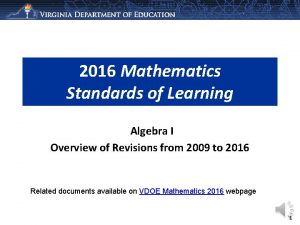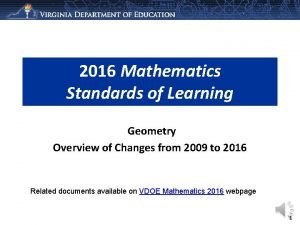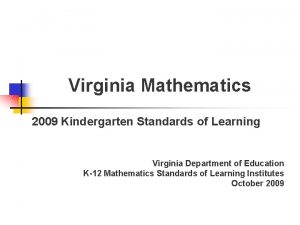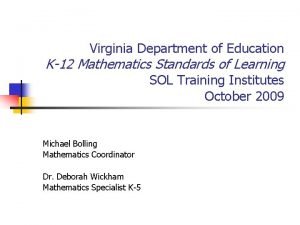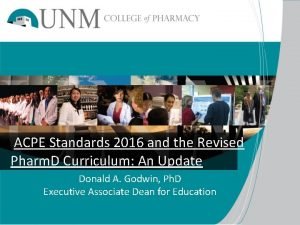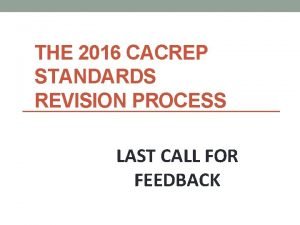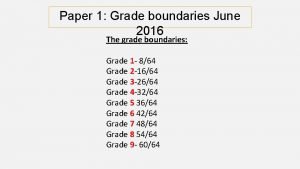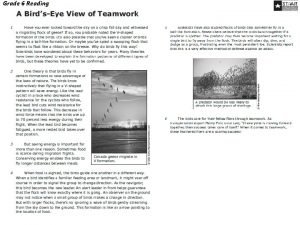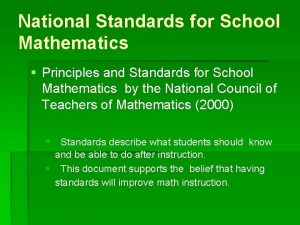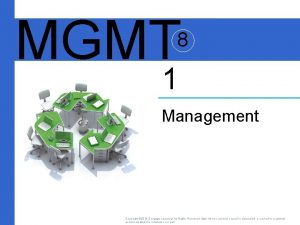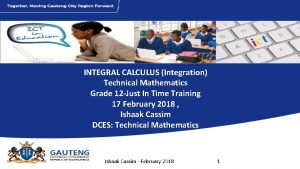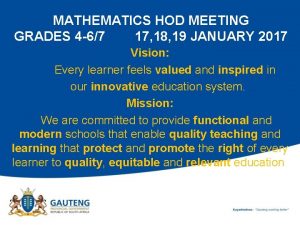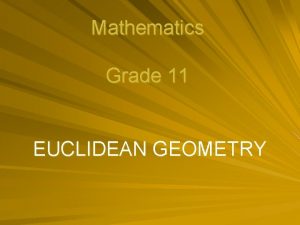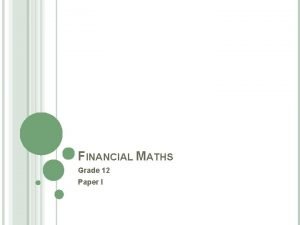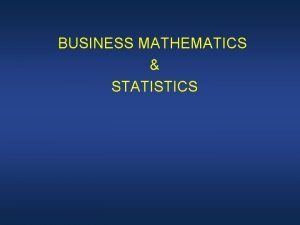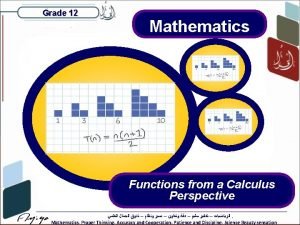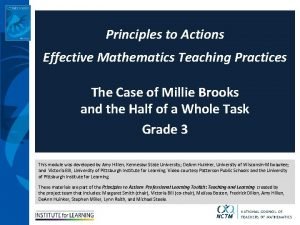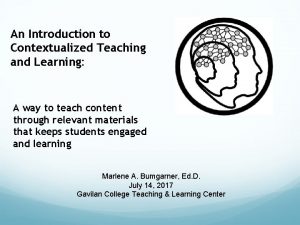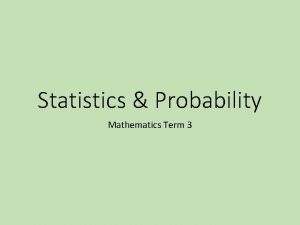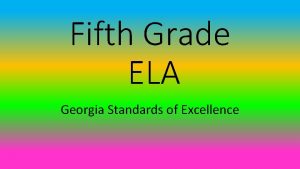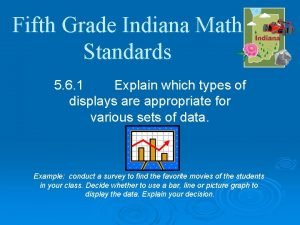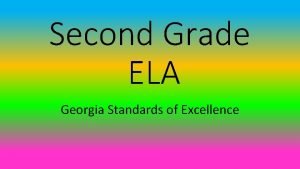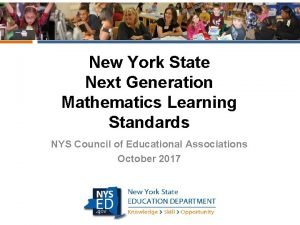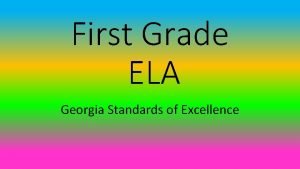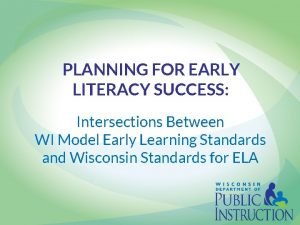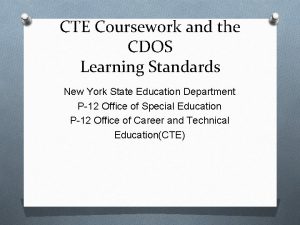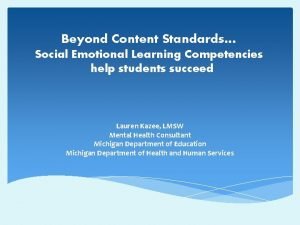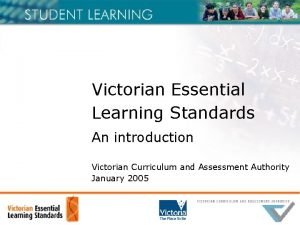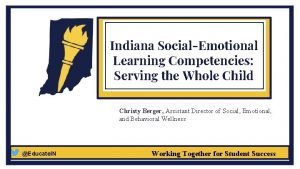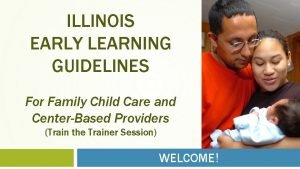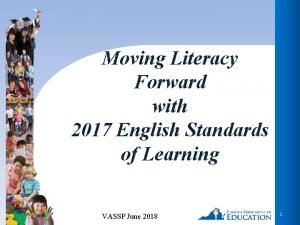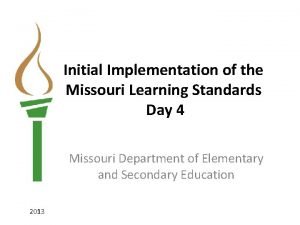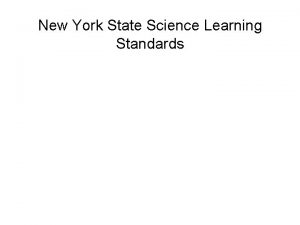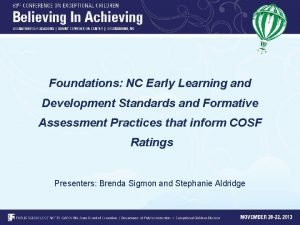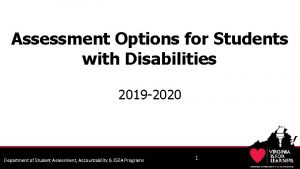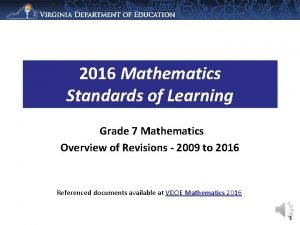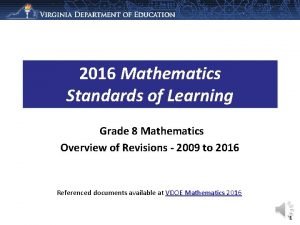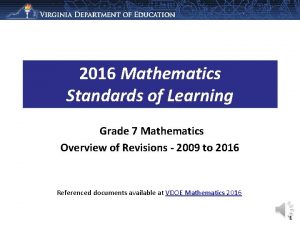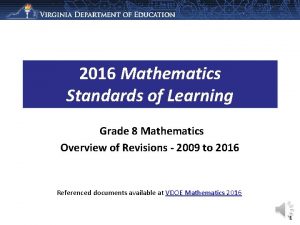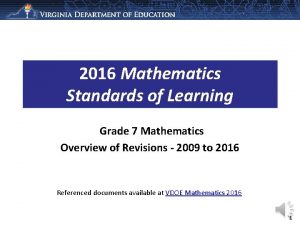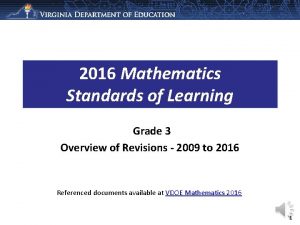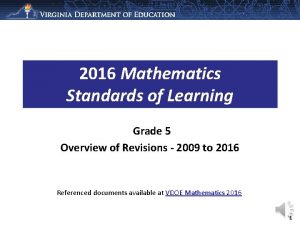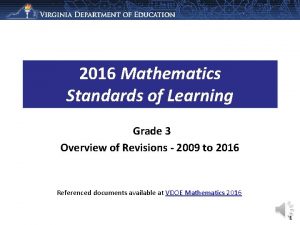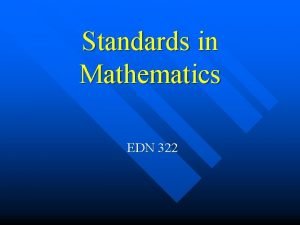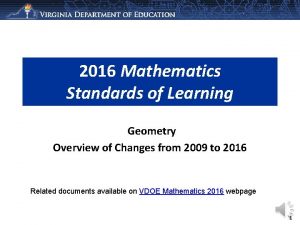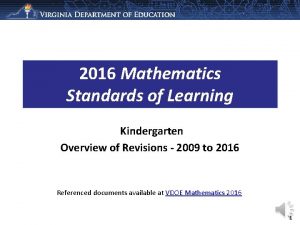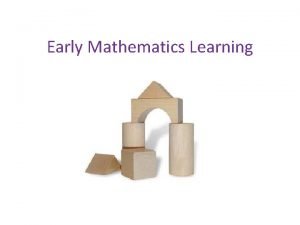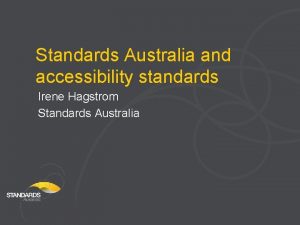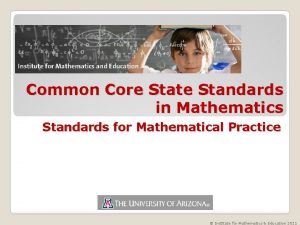2016 Mathematics Standards of Learning Grade 6 Mathematics








































- Slides: 40

2016 Mathematics Standards of Learning Grade 6 Mathematics Overview of Revisions - 2009 to 2016 Referenced documents available at VDOE Mathematics 2016 1

Purpose • Overview of the 2016 Mathematics Standards of Learning and the Curriculum Framework • Highlight information included in the Essential Knowledge and Skills and the Understanding the Standard sections of the Curriculum Framework 2

Agenda • Implementation Timeline • Resources Currently Available – Crosswalk (Summary of Revisions) – Standards and Curriculum Frameworks • Comparison of 2009 to 2016 Standards – – – Number and Number Sense Computation and Estimation Measurement and Geometry Probability and Statistics Patterns, Functions, and Algebra 3

Implementation Timeline 2016 -2017 School Year – Curriculum Development VDOE staff provides a summary of the revisions to assist school divisions in incorporating the new standards into local written curricula for inclusion in the taught curricula during the 2017 -2018 school year. 2017 -2018 School Year – Crossover Year 2009 Mathematics Standards of Learning and 2016 Mathematics Standards of Learning are included in the written and taught curricula. Spring 2018 Standards of Learning assessments measure the 2009 Mathematics Standards of Learning and include field test items measuring the 2016 Mathematics Standards of Learning. 2018 -2019 School Year – Full-Implementation Year Written and taught curricula reflect the 2016 Mathematics Standards of Learning assessments measure the 2016 Mathematics Standards of Learning. 4

2016 SOL Revisions – • Improve the vertical progression of mathematics content • Ensure developmental appropriateness of student expectations • Increase support for teachers in mathematics content (including definitions, explanations, examples, and instructional connections) • Clarify expectations for teaching and learning • Improve precision and consistency in mathematical language and format • Ensure proficiency of elementary students in computational skills 5

Changes to the Curriculum Framework • Reduction of columns from 3 to 2 – Understanding the Standard (US) – information that supports mathematical content knowledge – Essential Knowledge and Skills (EKS) – information that provides expectations for student learning • Indicators of SOL sub-bullet added to each bullet within the Essential Knowledge and Skills • Objectives measured without a calculator on state assessments are indicated with an asterisk * 6

7

Overview – Math 6 2009 Strand 2016 # of Standards Number and Number Sense 5 4 Number and Number Sense Computation and Estimation 3 2 Computation and Estimation Measurement 2 Geometry 3 3 Measurement and Geometry Probability and Statistics 3 2 Probability and Statistics Patterns, Functions, and Algebra 4 3 Patterns, Functions, and Algebra 20 14 Total Strand Total 8

Mathematics Process Goals for Students “The content of the mathematics standards is intended to support the five process goals for students” - 2009 and 2016 Mathematics Standards of Learning Communication Connections Problem Solving Representations Mathematical Understanding Reasoning 9

Standards of Learning Curriculum Frameworks Introduction includes: • Mathematical Process Goals for Students • Instructional Technology • Computational Fluency New • Algebra Readiness • Equity 10

2009 2016 11

12

NUMBER AND NUMBER SENSE 13

2009 SOL 2016 SOL Revisions: • Clarifications were added to Understanding the Standard (US) • A fraction can express more than part-to-whole relationship (from elementary grades). It may express a measurement, an operator (multiplication), a quotient, or a ratio. Examples added. • Fractions may be used when determining equivalent ratios • Examples using ratios to represent different comparisons added to the US using a table 14

2009 SOL 6. 2 The student will 2016 SOL 6. 2 The student will a) investigate and describe fractions, decimals, and percents as ratios; [Moved to 6. 2 EKS] b) identify a given fraction, decimal, or percent from a representation; [Included in 6. 2 a] a) represent and determine equivalencies among fractions, mixed numbers, decimals, and percents; and * b) compare and order positive rational numbers. * c) demonstrate equivalent relationships among fractions, decimals, and percents; * and [Included in 6. 2 a] d) compare and order fractions, decimals, and percents. * [Included in 6. 2 b] Revisions: • 6. 2 a - Equivalencies limited to fractions with denominators of 12 or less or factors of 100 • 6. 2 b - Positive rational numbers include fractions, mixed numbers, decimals and percents with fractions limited to denominators of 12 or less or factors of 100 • 6. 2 b - Order up to 4 positive rational numbers *On the state assessment, items measuring this objective are assessed without the use of a calculator. 15

2009 SOL 6. 3 The student will 2016 SOL 6. 3 The student will a) identify and represent integers; b) order and compare integers; and b) compare and order integers; and c) identify and describe absolute value of integers. Revisions: • No revisions 16

2009 SOL 2016 SOL 6. 4 The student will demonstrate multiple representations of multiplication and division of fractions. [Moved to 6. 5 EKS] Revisions: • See 6. 5 EKS, Computation and Estimation strand 17

2009 SOL 6. 5 The student will investigate and describe concepts of positive exponents and perfect squares. 2016 SOL 6. 4 The student will recognize and represent patterns with whole number exponents and perfect squares. Revisions: • Exponents may be whole numbers 18

COMPUTATION AND ESTIMATION 19

2009 SOL 6. 6 The student will 2016 SOL 6. 5 The student will a) multiply and divide fractions and mixed numbers; * and [Moved to 6. 5 a] a) multiply and divide fractions and mixed numbers; * b) estimate solutions and then solve single-step and multistep practical problems involving addition, subtraction, multiplication, and division of fractions. [Moved to 6. 5 b] b) solve single-step and multistep practical problems involving addition, subtraction, multiplication, and division of fractions and mixed numbers; and c) solve multistep practical problems involving addition, subtraction, multiplication, and division of decimals. [Moved from 6. 7] Revisions: • 6. 5 a & b - Fractions are defined as proper or improper and mixed numbers • 6. 5 c - Divisors limited to 3–digit number and decimal divisors limited to hundredths • 6. 5 c - Solve multistep practical problems with decimals included *On the state assessment, items measuring this objective are assessed without the use of a calculator. 20

2009 SOL 2016 SOL 6. 7 The student will solve single-step and multistep practical problems involving addition, subtraction, multiplication, and division of decimals. [Moved to 6. 5 c] Revisions: • See 6. 5 c in the 2016 standards 21

2009 SOL 2016 SOL 6. 8 The student will evaluate whole number numerical expressions, using the order of operations. * [Combined with 6. 6 c] New 6. 6 The student will a) add, subtract, multiply, and divide integers; * [Moved from 7. 3] b) solve practical problems involving operations with integers; and [Moved from 7. 3 EKS] c) simplify numerical expressions involving integers. *[Moved and modified from 6. 8] Revisions: • 6. 6 a - Moved from 7. 3 and 6. 8 • Emphasis on formulating rules for operations of integers through concrete experiences • 6. 6 b - Operations with two integers and solve practical problems • 6. 6 c - Use order of operations and apply properties of real numbers to simplify expressions involving more than 2 integers including absolute value, exponents limited to 1, 2, and 3 and bases limited to whole numbers • 6. 6 c - Expressions may have no more than 3 operations *On the state assessment, items measuring this objective are assessed without the use of a calculator. 22

MEASUREMENT AND GEOMETRY 23

2009 SOL 2016 SOL 6. 9 The student will make ballpark comparisons between measurements in the U. S. Customary System of measurement and measurements in the metric system. [Included in 7. 3 EKS] Revisions: • Removed from Grade 6 and included in 7. 3 EKS 24

2009 SOL 6. 10 The student will a) define π (pi) as the ratio of the circumference of a circle to its diameter; b) solve practical problems involving circumference and area of a circle, given the diameter or radius; c) solve practical problems involving area and perimeter; and 2016 SOL 6. 7 The student will a) derive π (pi); b) solve problems, including practical problems, involving circumference and area of a circle; and c) solve problems, including practical problems, involving area and perimeter of triangles and rectangles. d) describe and determine the volume and surface area of a rectangular prism. [Included in 7. 4 a] Revisions: • See 7. 4 - Volume and surface area of a rectangular prism 25

2009 SOL 6. 11 The student will 2016 SOL 6. 8 The student will a) identify the coordinates of a point in a coordinate plane; and [Included in 6. 8 b] a) identify the components of the coordinate plane; and [Moved from 6. 11 EKS bullet] b) graph ordered pairs in a coordinate plane. b) identify the coordinates of a point and graph ordered pairs in a coordinate plane. Revisions: • 6. 8 a - Coordinate values limited to integers • 6. 8 b EKS - Draw polygons in the coordinate plane given coordinates and determine the length of a side joining points with the same first or second coordinate [Moved from 6. 12] 26

2009 SOL 6. 12 The student will determine congruence of segments, angles, and polygons. 2016 SOL 6. 9 The student will determine congruence of segments, angles, and polygons. Revisions: • Identify regular polygons • Draw lines of symmetry to divide regular polygons into two congruent parts 27

2009 SOL 2016 SOL 6. 13 The student will describe and identify properties of quadrilaterals. [Included in 7. 6] Revisions: • Removed from Grade 6 and included in 7. 6 28

PROBABILITY AND STATISTICS 29

2009 SOL 6. 14 The student, given a problem situation, will 2016 SOL 6. 10 The student, given a practical situation, will a) construct circle graphs; a) represent data in a circle graph; b) draw conclusions and make predictions, using circle graphs; and b) make observations and inferences about data represented in a circle graph; and c) compare and contrast graphs that present information from the same data set. c) compare circle graphs with the same data represented in bar graphs, pictographs, and line plots. Revisions: • 6. 10 a - Data values limited to allow for comparisons that have denominators of 12 or less or those that are factors of 100 • 6. 10 c - Compare circle graphs with bar graphs, pictographs, and line plots 30

2009 SOL 6. 15 The student will a) describe mean as balance point; and b) decide which measure of center is appropriate for a given purpose. 2016 SOL 6. 11 The student will a) represent the mean of a data set graphically as the balance point; and b) determine the effect on measures of center when a single value of a data set is added, removed, or changed. [Moved from 5. 16 EKS] Revisions: • 6. 15 b - removed • 6. 11 a - Represent mean as a balance point graphically on a line plot • 6. 11 b - New 31

2009 SOL 2016 SOL 6. 16 The student will a) compare and contrast dependent and independent events; [Moved to 8. 11 a] and b) determine probabilities for dependent and independent events. [Included in 8. 11 b] Revisions: • Removed from Grade 6 and included in 8. 11 b 32

PATTERNS, FUNCTIONS, AND ALGEBRA 33

2009 SOL 2016 SOL 6. 17 The student will identify and extend geometric and arithmetic sequences. [Included in AFDA. 1 and AII. 5] Revisions: • Removed from grade 6 and included in AFDA. 1 and AII. 5 34

2009 SOL 2016 SOL 6. 12 The student will New a) represent a proportional relationship between two quantities, including those arising from practical situations; b) determine the unit rate of a proportional relationship and use it to find a missing value in a ratio table; c) determine whether a proportional relationship exists between two quantities; and d) make connections between and among representations of a proportional relationship between two quantities using verbal descriptions, ratio tables, and graphs. Revisions: • Represent proportional relationships between 2 quantities; determine the unit rate; complete ratio tables; determine if a proportional relationship exits; make connections among different representations • 6. 12 b - Unit rates are limited to positive values • Examples added in the US 35

2009 SOL 6. 18 The student will solve one-step linear equations in one variable involving whole number coefficients and positive rational solutions. 2016 SOL 6. 13 The student will solve one-step linear equations in one variable, including practical problems that require the solution of a onestep linear equation in one variable. Revisions: • Solve practical problems with one-step linear equations • Coefficients are limited to integers and unit fractions • Numeric terms are limited to integers • Apply properties of real numbers and properties of equality • EKS – Write verbal expressions and sentences as algebraic expressions and sentences and vice versa New 36

2009 SOL 2016 SOL 6. 19 The student will investigate and recognize a) the identity properties for addition and multiplication; b) the multiplicative property of zero; and c) the inverse property for multiplication. [Included in EKS and US for 6. 6, 6. 13, and 6. 14] Revisions: • Moved to 6. 6, 6. 13 and 6. 14 Understanding the Standard • The focus is not to identify a specific property being used, but correctly apply the properties. 37

2009 SOL 6. 20 The student will graph inequalities on a number line. 2016 SOL 6. 14 The student will a) represent a practical situation with a linear inequality in one variable; and b) solve one-step linear inequalities in one variable, involving addition or subtraction, and graph the solution on a number line. Revisions: • 6. 14 b - Apply properties of real numbers and properties of equality/inequality • 6. 14 b - Solve one-step linear inequalities in one variable involving addition and subtraction • 6. 14 b - Numeric terms are limited to integers • 6. 14 a, b - Identify a numerical value that is a part of the solution set of a given inequality 38

Middle School Revisions Leading to Algebra I 39

Questions? Please contact us! Mathematics@doe. virginia. gov 40
 2016 mathematics standards of learning
2016 mathematics standards of learning 2016 mathematics standards of learning
2016 mathematics standards of learning 2009 mathematics standards of learning answers
2009 mathematics standards of learning answers Vdoe geometry standards 2016
Vdoe geometry standards 2016 Acpe standards 2016
Acpe standards 2016 2016 cacrep standards
2016 cacrep standards Cuadro comparativo e-learning m-learning b-learning
Cuadro comparativo e-learning m-learning b-learning To a daughter leaving home and poem for my sister
To a daughter leaving home and poem for my sister Staar grade 6 reading 2016 released
Staar grade 6 reading 2016 released Principles and standards for school mathematics
Principles and standards for school mathematics Mgmt+8
Mgmt+8 Factors necessary for service standards are
Factors necessary for service standards are Integration grade 12
Integration grade 12 Hod management plan template
Hod management plan template Grade 11 euclidean geometry revision
Grade 11 euclidean geometry revision Grade 12 finance questions
Grade 12 finance questions Ratio in business mathematics
Ratio in business mathematics Functions from a calculus perspective
Functions from a calculus perspective Establish mathematics goals to focus learning
Establish mathematics goals to focus learning Contextualized learning examples
Contextualized learning examples Learning intentions and success criteria for mathematics
Learning intentions and success criteria for mathematics Elagse
Elagse Indiana math standards
Indiana math standards 2nd grade gse ela standards
2nd grade gse ela standards Next generation math standards grade 2
Next generation math standards grade 2 Oklahoma 3rd grade math standards
Oklahoma 3rd grade math standards Elagse
Elagse Wmels
Wmels Cte programs of study
Cte programs of study Social emotional learning standards michigan
Social emotional learning standards michigan Victorian essential learning standards
Victorian essential learning standards New jersey social emotional learning standards
New jersey social emotional learning standards Social emotional learning standards indiana
Social emotional learning standards indiana Illinois early learning guidelines
Illinois early learning guidelines Social emotional learning standards washington state
Social emotional learning standards washington state 2017 english standards of learning curriculum framework
2017 english standards of learning curriculum framework How to write missouri learning standards
How to write missouri learning standards New york state science standards
New york state science standards Nc early learning standards
Nc early learning standards Vaap manual
Vaap manual Deped transmutation table
Deped transmutation table
